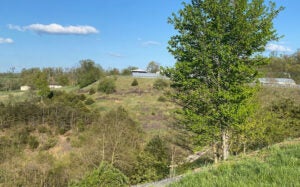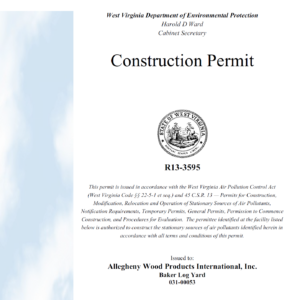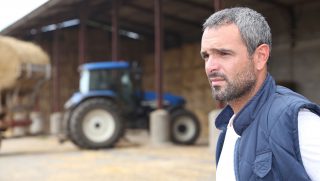The regulatory chasm between state lawmakers and Hardy County officials is contributing to people’s concerns about the use of highly toxic methyl bromide.
Miles Park’s father lost his Hardy County, West Virginia, agricultural operation seven years ago, and Park can see the empty poultry houses and idle farmland a couple of hundred feet from his porch.
But a recent permit application for a timber fumigation facility to be set up at that site has drawn a backlash from Park’s family and from others in their rural community, who are concerned about the amount of a highly toxic chemical that would be released into the air and are questioning whether state officials considered the needs and health of nearby residents before looking to greenlight the project.
“The state legislature keeps approving things that limit the county and local governments’ ability to regulate agriculture or even define what agriculture is,” Park said. “They’re putting in a facility that, by all rights and means, should be declared industrial on agricultural ground.”
The timber fumigation process in the United States uses a pesticide called methyl bromide, a substance that is known to significantly deplete the ozone layer. For that reason, it was targeted for massive restrictions at the Montreal Protocol in 1987 and, since 2005, has been expunged from almost all uses in the U.S. aside from timber fumigation.
In fact, the use of methyl bromide has dropped 90 percent since that time, particularly since it’s not applied to agricultural soils anymore, said Dr. Marshall White, Professor Emeritus in the Department of Wood Science & Forest Products at Virginia Tech. Most states have drastically limited permitting of fumigation projects, and Maryland and Hawaii have outlawed methyl bromide entirely around many populated areas.
“Even though there’s not enough methyl bromide going into the atmosphere now to impact the ozone level — the level is repairing itself, the ozone layer is becoming healthy — now it’s a toxicity issue, now it’s a human health issue domestically,” said White, who has been working under a U.S. Department of Agriculture grant to find a non-chemical timber alternative to methyl bromide.
Yet until a safer alternative is accepted internationally, Hardy County in northeastern West Virginia is an ideal launching point for white oak, walnut, and other veneer-quality timber to be treated and shipped to major East Coast export ports, such as Baltimore and Philadelphia.
Park’s wife, Sharon, fought through tears in a Facebook Live video soon after learning of a West Virginia Department of Environmental Protection notice of intent to approve the permit for a fumigation facility on Park Farm Drive.
The permit would allow Allegheny Wood Products International to relocate from a facility in Moorefield that has been sold and to construct a new fumigation building adjacent to the Parks’ residence near Baker, West Virginia. According to the permit, the company could reach potential usage of 9.55 tons per year of methyl bromide, a substance that, according to the Centers for Disease Control and Prevention and Environmental Protection Agency, can cause coughing and dyspnea, which can develop into pneumonitis and pulmonary edema, after inhalational exposure. The worst exposures can result in neurological damage, seizures, coma, and death.
“I’m terrified. All my neighbors are,” Sharon Park said, wondering how it will also affect farmers in her area as well as their cattle and the nearby wildlife. “We all need to speak up, because it’s not just about my home.”

Multiple letters and opinions have been voiced in the local weekly newspaper, The Moorefield Examiner, all expressing heightened concern about the facility.
One opinion article stated bluntly, “Residents’ health and the environment don’t matter versus the opportunity for wealth, when there is minimal regulation and oversight in rural areas. Opponents of projects that threaten their well-being step into the run against a foregone conclusion above their weight class.”
The outcry from the community has gained traction, helping push the scheduling of a public hearing on May 4.
Yet what’s happening now in West Virginia isn’t uncommon on the East Coast when timber treatment facilities try to set up shop in areas close to occupied dwellings. A town hall meeting was conducted outside of Wilmington, North Carolina, when Malec Brothers Transport wanted to fumigate with methyl bromide. And drift from a fumigation facility near Baltimore led to a backlash and outright ban on the chemical, which triggered an exodus of facilities to neighboring West Virginia in recent years.
“Regions in North Carolina have gone through the same thing that this couple is concerned about, and believe me, it’s gone on in every state where someone wants to put in a fumigation facility,” White explained. “Local citizens get up in arms, and eventually they don’t give the permit or they give the permit with some additional restrictions. Something is worked out.”
While health concerns have been at the forefront for the Parks, the way the permitting process has played out so far has also been jarring for the family and local officials.
Many local stakeholders were alerted to the project thanks to a letter to the editor in the local newspaper, which referenced state officials’ intent to approve a permit for Allegheny Wood Products’ facility on the agriculturally zoned land.
Steven Schetrom said that, in the few years he has served as commissioner in Hardy County, this is the first time a facility of this magnitude was being done with no local input. In most instances, he said, there’s something at the county level, such as septic or water-usage permits, that would loop in county officials that this kind of project was being sought. It is a way to offer checks and balances at the local level for projects.
“It’s one reason why land-use policy is very important in Hardy County. We want to make sure that local voices are heard,” Schetrom said.
The engineering evaluation was conducted by Steven Pursley with the state Division of Air Quality and completed on January 30, almost three months before it was due. According to his report, Pursley did not visit the proposed log yard location in person but rather conducted his site investigation through Google Earth.
The agricultural-zoned land sits along a road that bears the Park family name. Miles Park says that his father, Max, placed the property into an agricultural land protective trust years before he was forced to sell it — with the expectation that the property could not be rezoned or reclassified for anything other than farming and ranching operations.
“That’s why you have zoning in the first place, to allow all parties to exist in peace and prosperity,” Schetrom said. “So you have residential areas, and everyone lives together. You don’t put an industrial project near a residential area. The same thing is true with agriculture. You need to have an order to things. And you’re making a promise. Buyers, businesses, and residents — there’s a promise to them that because this land has been zoned in such and such a way that it will be kept as that. They’re making an investment there based on their local elected representatives.”
And because hazardous materials will be used and stored in large quantities and because the timber is not being harvested on site but rather only treated there, many questions have come up about whether this project fits the letter — or the spirit — of agricultural zoning. To people like Schetrom, this feels more like an industrial project rather than an agricultural one.
In similar fashion, it’s common for a business such as a meat-processing facility, which uses products directly derived from an agricultural operation, to be on land zoned general industrial or light industrial because of the chemicals, processes, odors, and other factors that take place there.
Schetrom and several other Hardy County officials, including Planner Melissa Scott and leaders of the planning commission, sent a letter on Monday to the state Division of Air Quality, arguing that while state standards for this project may have been met, the requirements for Hardy County zoning compliance have not.
“While we understand it is not customary for state offices to include county regulatory processes in its decision making, in this case, we implore you to consider the fact that the proposed project is not currently permitted in the proposed location as per the Hardy County Zoning Ordinance,” the letter said.
Allegheny Wood Products did not return a request for an interview. The U.S. Environmental Protection Agency did not respond to a series of questions about methyl bromide registration and use prior to this article’s deadline.
Most permits related to timber fumigation are awarded for a period of time less than a year — 26 weeks, for example — though White from Virginia Tech said that these kinds of facilities are not set up to move locations regularly. Fumigation itself is a seasonal business, generally taking place from mid-October to the end of April. That’s when the logs can be shipped overseas in the cooler months and not be subjected to drying out and degrading in shipping containers during summer.
“Methyl bromide volatilizes. You cannot treat logs when the temperature drops below 40 degrees Fahrenheit, because it does not volatilize at that point,” White said. “That’s why it’s ironic that it’s a winter-season business. So if you’re treating a log, it’s generally in a heated building, depending on where you are.”
Treatment of logs adheres to the U.S. Department of Agriculture’s Manual T312, which describes measures such as the required on-site sensors and the allowable chemical concentrations. Coupled with the EPA’s registration of the chemical and state-level environmental inspections and oversight, several agencies have their hands in the methyl bromide fumigation regulatory process.
Many logs at these sites are shipped in from the Midwest, with Ohio and Missouri being prime sources for oak and walnut. West Virginia itself, as well as Pennsylvania, are common suppliers to these operations, too.
Once logs are treated, after a period of anywhere from 16 to 72 hours, the methyl bromide is vented. Workers who are applying the chemical need to have respirators on, and there are restrictions on how close they can be to the products. The treated logs are often tarped.
Methyl bromide is wildly expensive, and the amount of methyl bromide released into the air is tightly controlled. Businesses must have paperwork to show what was purchased and how much is left, so that officials can best gauge how much went into the air.
That can help inform how much of an impact the chemical will have on the people, animals, and land around it.
“It’s all about the air and getting out into the atmosphere and drifting. And it does,” White said. “The volatile doesn’t change chemically in the air; it doesn’t oxidize into any other form. And it’s extremely toxic.”
Several steps are still required — including the public hearing — before construction would begin at the site near the Park family. And the complexity of residential health concerns, state economic interests, and open and transparent communication between state and local governments weigh heavily on the process.
Miles Park doesn’t want to see his father’s land used in any way beyond agriculture, and he doesn’t believe that Allegheny Wood Products is adhering to the zoning of the land. Thirty years ago, Park and his father built the water system that the properties share and that was a vital component to the poultry operation. The fact that part of that system — including storage tanks, a valve building, and a portion of the underground lines — are on his father’s former land exacerbates the use and contamination fears he has.
The West Virginia Department of Environmental Protection’s public meeting on May 4 is being held virtually, and turnout is expected to be large. There will be a question-and-answer segment as well as an oral public comment period during the meeting. Written comments will be accepted until May 12.
For many, the hope is to understand what kind of facility and precautionary measures are going to be created and where exactly on the property in relation to occupied dwellings it will be. Others are likely seeking to better bridge the gap between the actions and regulatory decisions made at the state level and the interests of people at the local level.
“There’s never going to be a good situation arising by not allowing the voices of local people to be heard,” Schetrom said.
Ryan Tipps is the founder and managing editor of AGDAILY. The Virginia Tech graduate has covered farming since 2011, and his writing has been honored by state- and national-level agricultural organizations.



